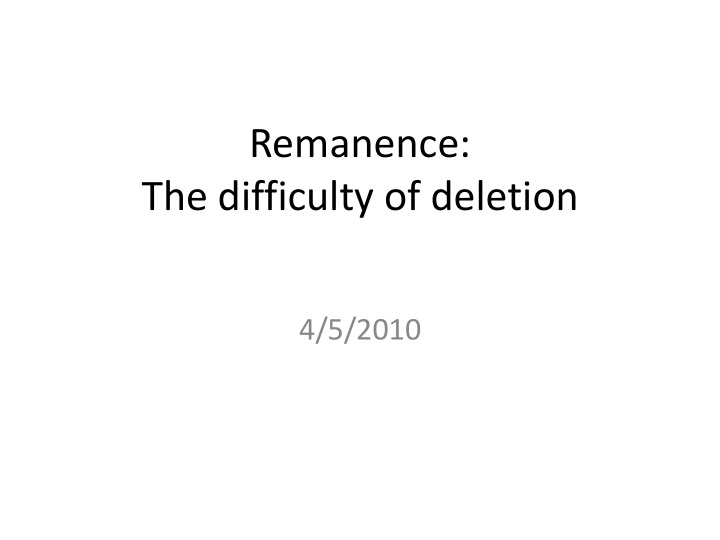



Remanence: The difficulty of deletion 4/5/2010
Administrative Announcements • All discussion sections are cancelled tomorrow (4/6)
Remanence on hard disk • Deleting a file does not delete the file – … even if you empty the Trash – Contents of file remain on disk; only the link from its containing directory is deleted • A usability flaw: users might reasonably expect “delete” to mean “delete”, but it doesn’t • Solution? Use a secure file delete program
Remanence on hard disk • Formatting a drive does not delete the data on it – It just deletes the filesystem metadata – 2002 study bought & imaged 129 second-hand hard drives: 12 (9%) had been properly sanitized. 81 (63%) had deleted-but-recoverable files. 42 (32%) had credit card numbers. One was from an ATM; another had 3,722 credit cards. • Solution? Use disk-wipe software (e.g., DBAN) that securely overwrites all sectors of the disk – Warning: on a modern disk, this can take days (!)
Remanence on disk • If hard disk detects a failing sector, it automatically copies the data to another sector and remaps the sector (transparently) – This might cause sensitive data to remain on your hard disk long after you thought you deleted it • Secrets stored in memory might get copied to disk during paging, or during suspend-to-disk – You think you deleted the secret from memory, but it still remains on your hard disk longer than expected
Remanence in memory • What’s wrong with this code? void f() { char passwd[64]; if (getpass(passwd) == 0) dostuff(passwd); memset(passwd, 0, sizeof(passwd)); } • Answer: The compiler might optimize the memset() away!
Remanence in hardware
Recovering data from hard disks • When overwriting a track, the head may not be perfectly aligned both times, leaving remnants of the “deleted” data
DRAM memory • DRAM cells need to be refreshed, or else they lose their memory of what was stored – System automatically refreshes them, e.g. every 90 ns • What if DRAM cell isn’t refreshed? – Turns out data can remain for 2-35 seconds – At lower temperatures, data lasts longer
Implications • Attacker with physical access to your laptop can recover any secrets stored in memory • Example: You use disk encryption software, which stores crypto key in memory. You set a strong password and rely upon OS to prevent access to this memory. You engage a screenlock, or suspend-to- RAM, and walk through security checkpoint. – Attacker who steals your computer can freeze your RAM chip, then reboot via USB (or: freeze chips, remove them, place them in his own laptop), and learn your crypto key, even though he doesn’t know your login password.
Defenses? • When crypto keys are stored in memory, periodically flip all their bits
Flash memory • Each bit of flash storage can only be written a limited number of times (e.g., 10,000x); after that, it breaks down and no longer works. • To address this, many flash subsystems use “wear levelling ”. • But wear levelling creates its own risks – it means that “overwriting” a file may not overwrite the data stored in flash, but may just overwrite a copy of the data.
The difficulty of redaction
NY Times publishes redacted document
Ayatollah Behbehani Farzanegan
Redacting in Microsoft Word
Redacting in Microsoft Word
Redacting in Microsoft Word
Redacting in Microsoft Word
This doesn’t work! When the Word document is exported to PDF: This is a usability flaw in Microsoft Word (and in some PDF editors, too).
IRAQ – ITS INFRASTRUCTURE OF CONCEALMENT, DECEPTION AND INTIMIDATION This report draws upon a number of sources, including intelligence material, and shows how the Iraqi regime is constructed to have, and to keep, WMD, and is now engaged in a campaign of obstruction of the United Nations Weapons Inspectors. Part One focusses on how Iraq’s security organisations operate to conceal Weapons of Mass Destruction from UN Inspectors. It reveals that the inspectors are outnumbered by Iraqi intelligence by a ratio of 200 to 1. Part Two gives up to date details of Iraq’s network of intelligence and security organisations whose job it is to keep Saddam and his regime in power, and to prevent the international community from disarming Iraq. Part Three goes on to show the effects of the security apparatus on the ordinary people of Iraq. While the reach of this network outside Iraq may be less apparent since the Gulf War of 1990/1991, inside Iraq, its grip is formidable over all levels of society. Saddam and his inner circle control the State infrastructure of fear.
Rev. #1: "cic22" edited file "C:\DOCUME~1\phamill\LOCALS~1\Temp\AutoRecovery save of Iraq - security.asd“ Rev. #2: "cic22" edited file "C:\DOCUME~1\phamill\LOCALS~1\Temp\AutoRecovery save of Iraq - security.asd“ Rev. #3: "cic22" edited file "C:\DOCUME~1\phamill\LOCALS~1\Temp\AutoRecovery save of Iraq - security.asd“ Rev. #4: "JPratt" edited file "C:\TEMP\Iraq - security.doc“ Rev. #5: "JPratt" edited file "A:\Iraq - security.doc“ Rev. #6: "ablackshaw" edited file "C:\ABlackshaw\Iraq - security.doc“ Rev. #7: "ablackshaw" edited file "C:\ABlackshaw\A;Iraq - security.doc“ Rev. #8: "ablackshaw" edited file "A:\Iraq - security.doc“ Rev. #9: "MKhan" edited file "C:\TEMP\Iraq - security.doc“ Rev. #10: "MKhan" edited file "C:\WINNT\Profiles\mkhan\Desktop\Iraq.doc" Paul Hamill - Foreign Office official John Pratt - Downing Street official Alison Blackshaw - The personal assistant of the Prime Minister's press secretary Murtaza Khan - Junior press officer for the Prime Minister
Risks with Microsoft Word • Document may contain previous revisions – … which in some cases may reveal unrelated docs – or may reveal, e.g., which embarrassing details were deleted before publication, or what terms in the contract were changed • May reveal local filenames, usernames, author names, and other metadata
Defenses? • Print, then mark with ink, then scan
Recommend
More recommend